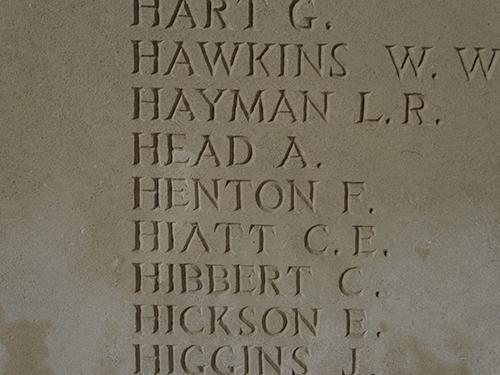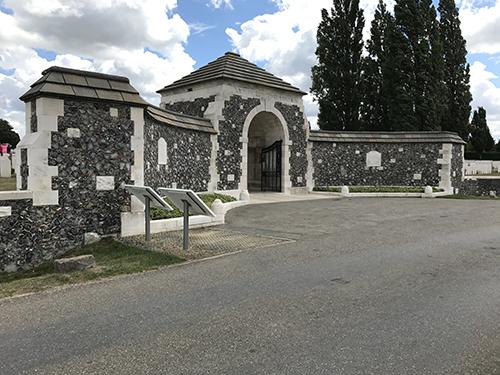Biography of Private Arthur Head (17920)
1st Battalion Lincolnshire Regiment
Died 16th April 1918
- Name: Arthur Head
Date of birth: 1890
Place of Birth: Barholm, Lincolnshire, England
Date of Birth Registration: July – September 1890
Place of Birth Registration: Stamford, Lincolnshire, England
- Name: Charles Head
- DOB: 1849
- Place of Birth: Dowsby, Lincolnshire, England
- Occupation: Railway labourer
- Name: Ann Currell
- DOB: 1851
- Place Of Birth: Watton, Hertfordshire, England
- Marriage: 1874 Stamford District
Siblings: (Name), (DOB), (POB)
- Charles Robert Head, 1874, Belmesthorpe (Died 1906)
- Richard Head, 1876, Little Bytham (Died 1876)
- John William Head, 1878, Little Bytham (Died 1876)
- John William Head, 1877, Little Bytham (Died 1877)
- John Edwin Head, 1878, Little Bytham
- George Head, 1880, Little Bytham
- Lucy Head, 1882, Little Bytham (Died 1882)
- Lizzie Head, 1883, Barholm
- Mary Jane Head, 1885, Barholm (Died 1887)
- Kate Head, 1888, Barholm
- Arthur Head, 1890, Barholm
- Sarah Jane Head, 1892, Barholm
- The 1911 census gives 13 children, 6 living and 7 dead. Only 1 child we cannot find being registers.
- 1891: Arthur is living with his parents in Barholm, Lincolnshire.
- 1901: Arthur is living with his parents in Wilsthorpe, Lincolnshire
- 1911: Arthur is living with his parents in Wilsthorpe, Lincolnshire. The census gives him an age of 20 and he is listed as a farm labourer.
- None found
- No marriage for Arthur has been found and because of his age we can assume that he never had the opportunity to marry.
Newspaper Mentions
- War Office Weekly Casualty List Deacember 18th 1918
WOUNDED
LINCOLNSHIRE REGIMENT
Head 17920 A. (Manthorpe)
Military Records
- None found
- These records show that Private Arthur Head, 17920, 1st Bn Lincolnshire Regiment was killed in action on 16th April 1918 in the Western European Theatre in France and Flanders.
Pension Records
- Available
Effects Left To
- Father Charles
- The British Medal
The Victory Medal
- UK:
- Witham on the Hill, Roll of Honour in St Andrew’s Church
- Bourne War Memorial in the Memorial Gardens
- Commonwealth War Graves Commission:
- In memory of Private Arthur Head, 17920, 1st Bn., Lincolnshire Regiment who died on 16 April 1918 Age 28
- Son of Mr. and Mrs. Charles Head, of Morton, Bourne, Lincs.
- Remembered with honour, Tyne Cot Memorial

© Picture taken by South Lincolnshire War Memorials

© Picture taken by South Lincolnshire War Memorials
Military Service Timeline
-
Currently we are unable to access the official military record for Arthur. As 60% of all WW1 records were destroyed in a fire in the blitz, it is most likely that it no longer survives.
We know he enlisted into the Army in Bourne and that he was resident in Manthorpe at that point in time, although the exact date is not known. The medal rolls show that Arthur only ever served with the 1st Battalion Lincolnshire Regiment as a private and as there is no entitlement to a 14 or 15 star, then he must have first seen service abroad in 1916 or later.
The first mention of Arthur in any military document we can find is on the 13th December 1917 where Arthur, then serving with C Company the 1st Battalion Lincolnshire Regiment appears in the records of the 31st ambulance train. These show that Arthur is entrained at Aubigny and detrained at Etaples, at the time one of the largest hospital complexes in France. He is admitted onto ward E and diagnosed with Tonsillitis. Unusually the record also shows that he was discharged back to duty on the same day.
The war office daily list number 5442 of 14th December lists Arthur as wounded, the next of kin address is Manthorpe. It is unclear if he was wounded and, in being treated, he is also diagnosed with tonsillitis. This is the most likely explanation as some of these lists have a delay in posting information due to communications.
We can assume that Arthur rejoined his unit if not on the 13th when discharged, then at some time after this date. At that time the 1st Battalion were in the line near Villers Guislan between Saint-Quentin and Cambrai as they had been since after the Battle of Cambrai.
January was spend in and out of the lines in regular tours around Heudicourt still in the same sector as December. February was a similar story with training being carried out at Moislains when not in the Line at Leiramont, both just south west of Epehy. During the beginning of March it was the the same story although this changed very quickly after the 15th March with the enemy spring offensive in full swing then battalion were forced into withdrawl after withdrawal, their final retirement, and most noted defence, was that of Chapel Hill. At the end of March they were pulled back into Bourdan sur somme, west of Amiens and billeted for the night.
April 1st started with the Battalion being moved from the cap at 12 noon and then entrained at Hengest at 1.30pm for a slow journey to Pezelhoek and then by bus to Ramilies Camp at Kemmel arriving at 3am (2nd April) after 14 hours of travelling.
After a couple of days out of the line the battalion went back into the trenches on the 4th April near Kemmel, the front line being between Wall farm and Wambeke. On their third day in the trenches a draft of 90 other ranks was received.
The next night there was some shelling on the line between Kemmel and Wytschaete and on that night, 7th April, the Battalion came back out of the line and back to Ramillies Camp at Kemmel.On the 8th April the companies were reorganised and the new draft of 90 men were posted to the companies. Albert was previously in C company and it is assumed that being a private he started with he company. The next day the Battalion was drilled and received specialist training in signalling, Lewis gunnery and first aid training, before being taken by light railway on the 10th April to Otaga Camp.
At Zillebeke Lake the Battalion revlieved the 1st East Yorks. At 8.30pm the C.O. received a summons to brigade HQ at Bedford Hose and was informed that the Battalion was to move at once to Maida Camp and come under the orders of 64th Infantry Brigade.On the 11th the Battalion was ordered to Lincoln Camp and that in the early morning hey would make an attack. His planned operation was cancelled at 11.30pm and the Battalion went back into support for the 62nd Brigade at Regent Dugout south of the Kemmel-Wytscaete Road.
The 12th saw the Battalion prepare to take over the front line by making reconnaissance, preparing stores etc. in the afternoon the enemy made an unsuccessful attention to take Wulverghem and the Battalion watched this from their position. At 9pm the relief of the front line commenced and this was completed at 11.40pm.
The Battalion Diary notes that the period of the 12th to the 19th was best described by reproducing the official account of the operation, sent by Brigadier general G H Gater DSO, commanding 2nd Infantry Brigade to the next higher command.
On the evening of the 12th 13th of April, the 1st Lincolnshire Regiment relieved the 12/13th Northumberland Fusiliers in the Wytschaete sector. The battalion was responsible for holding the line from Bogaert Farm exclusive on the right to Stanyzer Cabaret cross roads inclusive on the left, which line was extended on the night of the 15th and 16th to Scott farm. From that date until the attack on the Monday the 16th the Battalion was subjected to a very heavy and continuous bombardment which was made all the more trying for the men owing to the lack of shelter. Between the evening of 12/13 and the 15th 16th casualties amounted to 2 officers and 80 other ranks. The battalion only went into the line with 12 offices including Battalion H.Q., so that the strain on these few officers was tremendous. In spite of this the fighting spirit of all ranks was maintained at the highest level.
On the afternoon of the 13th the enemy shelled the village very heavily but owing to the vigilance of the Vickers and Lewis guns no infantry attack took place.
At 4:30 am on the morning of the 16th the enemy put down a terrific bombardment on our front line on the village and on all approaches. The bombardment lasted without any lull till 5:30 am, when it was lifted on the front of the left and centre battalions, but kept on the 1st Lincolnshire Regiment for 10 minutes longer. Under cover of dense fog the enemy attacked on the flanks of the battalion and succeeded in breaking our line just north of the Stanyzer Cabaret crossroads and at Peckham. Strong parts of the enemy then wheeled inwards and attacked both flanks of the battalion, the frontal attack does not appear to have been pressed.
Owing to the dense fog and bombardment it was impossible to get a clear idea of the situation and the companies did not know they were attacked until the enemy appeared at close quarters. Fighting under every disadvantage as the fog denied them the full use of Lewis guns and rifles it made it impossible to locate the enemy, the battalion stood firm and fought it out to the last. No officer, platoon post or individual surrendered and the fighting was prolonged until 6:30 am. Ample evidence of this is provided by the commanding officer and Battalion HQ, who made a last stand at the crossroads and did not leave there until 7 am. They, a mere handful of men, withdrew slowly fighting all the way through Wytschaete Wood.
The withdrawal was covered by the adjutant, Captain Mokellar, with revolver and bombs firing into the enemy at close quarters. This enabled the commanding officer Major Gush to get away his wounded and the commanding officer of the 12/13th Northumberland Fusiliers, who was also wounded.
The splendid behaviour of the Battalion undoubtably saved the situation by breaking the full force of the attack enabling a defensive flank to be formed covering, the 54th Brigade from North House to Black Cot and the reserve Battalion to be pushed up to the line Vandalge farm – Lagaghe Farm so as to prevent a further breakthrough.
The hard fighting left the enemy disorganised and unable to consolidate and materially assisted the counter-attack delivered in the evening.The battalion Diary for the 17th reports that “after having been relieved, in the position taken up after the enemy attack Wytschaete, by a composite battalion consisting of Seaforth’s, Gloucesters and Sussex Regiments the Battalion, now only five officers and 82 of the ranks strong, withdrew to Siege Farm North-West of Kemmel. Whilst in this position 21 stragglers who would become attached to other units during the fighting re-joined the battalion, making the total number of other ranks 103.
Private Arthur Head is reported as missing during the action of the 16th April 1918.
Arthur appears on the War Office daily list 5599, published 22nd June 1918, as reported missing.The official records eventually change to presumed dead on the 16th April 1918, the Army paymaster forwarding information that a pension was awarded on the 5th December, on to the pensions department on 12th October 1918. Mrs Anne Head, Mother, was to receive a pension for life from 17th December 1918.
- This is ongoing research and will be posted when completed
- WW1 Soldier’s Records (www.ancestry.co.uk)
Commonwealth War Graves Commission